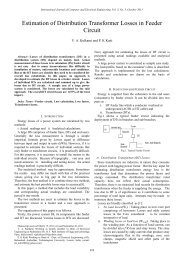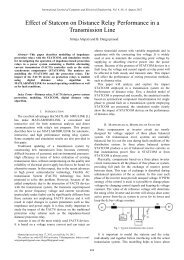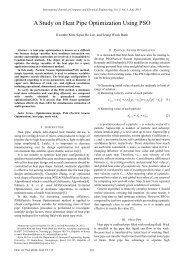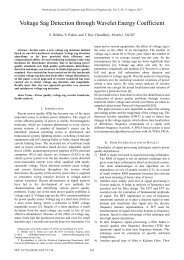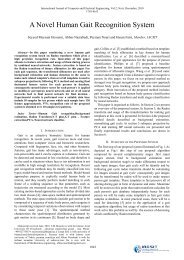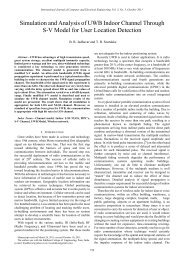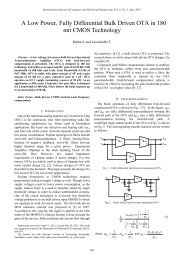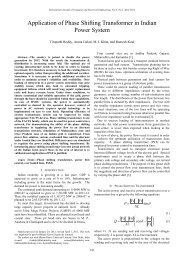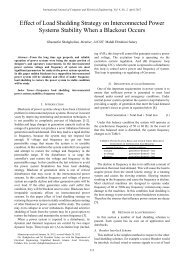<strong>International</strong> <strong>Journal</strong> <strong>of</strong> <strong>Computer</strong> <strong>and</strong> Electrical <strong>Engineering</strong>, Vol. 4, No. 6, December 2012 It is worth mentioning that the weights w 1 <strong>and</strong> w 2 have been introduced in the objective function (7) with a provision <strong>of</strong> balancing the impact <strong>of</strong> the error <strong>and</strong> control signal. The objective function ITAESCS in (7) is now minimized to find out the optimal set <strong>of</strong> controller parameters which simultaneously reduces the ITAE <strong>and</strong> control signal ut (). The time multiplication term in error index ITAE minimizes the chance <strong>of</strong> oscillation at later stages, thus effectively reducing the settling time ( t s ) <strong>of</strong> the closed loop system <strong>and</strong> the absolute value <strong>of</strong> error minimizes the percentage <strong>of</strong> overshoot (% M p ). The minimization <strong>of</strong> the squared control signal reduces the chance <strong>of</strong> actuator saturation <strong>and</strong> also reduces the size <strong>of</strong> the actuator <strong>and</strong> thus the cost involved. 3-5 <strong>and</strong> 6, respectively. The PID parameters areobtained for 30 iterations. In this example t f is equal to 10 seconds. Fig. 3. The parameter value trajectory K1 V. SIMULATION RESULTS In this study, a system simulation was carried out on the combination <strong>of</strong> the chaotic particle swarm optimization algorithm <strong>and</strong> the PID control system shown in Fig. 2. The input variable <strong>of</strong> the proposed CPSO-PID controller is the error et () <strong>and</strong> the output variable is the control signal ut (). On the one h<strong>and</strong>, to achieve the goal <strong>of</strong> minimizing the ITAESCS <strong>of</strong> the control system, we used the CPSO algorithm. The parameters <strong>of</strong> the CPSO Algorithm are set as shown in Table II. The sampling time in this simulation is 0.01 sec. In this section, in order to track the step input, the weights w 1 <strong>and</strong> w 2 <strong>of</strong> fitness function are chosen as 0.9998 <strong>and</strong> 0.0002, respectively. In order to compare the performance <strong>of</strong> the proposed method with the Ziegler-Nichols technique, a DC Motor is considered with the plant model described by: Fig. 4. The parameter value trajectory K2 1 G(s)= 3 2 s + 9s + 23s + 15 (8) The objective <strong>of</strong> this experiment is to compare the CPSO Algorithm tuning to that <strong>of</strong> the method <strong>of</strong> Ziegler-Nichols for DC Motor.For comparison, the following controllers are individually applied <strong>and</strong> simulated:(I) the PID controller with the parameters k p = 115.2 , k I = 177.2308 , <strong>and</strong> k D = 18.72 , which are determined by means <strong>of</strong> the ZN(ZN-PID), <strong>and</strong> (II) the CPSO-PID controller with the parameters k p = 57.3112 , k I = 24.4258 , k D = 15.8230 which are determined by means <strong>of</strong> the CPSO Algorithm.The searching ranges for the PID parameters k p , k I , <strong>and</strong> k D are limited to [0, 100]. Fig. 5. The parameter value trajectory K3 TABLE II: PARAMETERS USED IN THE CPSO Population size 20 Acceleration constant c 1 2 Acceleration constant c 2 2 started from 0.9 <strong>and</strong> decreased linearly Inertia weight w to 0.4 Number <strong>of</strong> iterations 30 A sample <strong>of</strong> the trajectory <strong>of</strong> the PID parameters <strong>and</strong> performance criterion during optimization is shown in Figs. Fig. 6. The performance criterion trajectory 836
<strong>International</strong> <strong>Journal</strong> <strong>of</strong> <strong>Computer</strong> <strong>and</strong> Electrical <strong>Engineering</strong>, Vol. 4, No. 6, December 2012 Fig. 7. The step responses <strong>of</strong> the DC Motor Fig. 8. The control signal TABLE III: PERFORMANCE COMPARISON WITH STEP RESPONSE Performance Settling time (Sec) Maximum overshoot ITAESCS (5%) (%) Ziegler-Nichols Method 2.89 60.3 1.5680 Proposed Method 1.12 0.5 0.8657 The step responses <strong>of</strong> the controllers mentioned above are simulated <strong>and</strong> the simulated responses are plotted in Fig. 7. The performance indices (settling time, maximum overshoot, <strong>and</strong> ITAESCS) <strong>of</strong> the simulated results are evaluated <strong>and</strong> these parameters are compared in Table III. It is shown that the proposed controller exhibits better performance as compared to Ziegler-Nichols method. In addition, according to Fig. 8, the proposed controller has created a limited control signal to set-point tracking in DC motor, because the control effort is appliedin the objective function (ITAESCS). VI. CONCLUSIONS This paper presents a novel approach to determining the parameters <strong>of</strong> an intelligent PID controller using the chaotic particle swarm optimization Algorithm. Without trial <strong>and</strong> error or experiences <strong>of</strong> designers, the PID gains are automatically optimized by using a chaotic particle swarm optimization Algorithm with a defined fitness function that is associated with the Integral <strong>of</strong> Time multiplied Absolute Error (ITAE) <strong>and</strong> squared control signal (ITAESCS) .Illustrative example has been presented to demonstrate that the performance <strong>of</strong> proposed controller is superior to the Ziegler-Nichols controller in terms <strong>of</strong> settling time, maximum overshoot, <strong>and</strong> ITAESCS. REFERENCES [1] K. Ogata, Modern Control <strong>Engineering</strong>, second ed., Prentice-Hall, India, 1992. [2] A. Pollard, Process Control, Heinemann Educational Books, London, 1971. [3] N. Saad <strong>and</strong> V. Kadirkamanathan, “A DES approach for the contextual load modelling <strong>of</strong> supply chain system for instability analysis,” Simulation Modelling Practice <strong>and</strong> <strong>Theory</strong>, vol. 14, pp. 541–563, 2006. [4] A. Visioli, “Tuning <strong>of</strong> PID controllers with fuzzy logic,” in Proc. <strong>of</strong> Inst. Elect. Eng. Contr. <strong>Theory</strong> Applicat, vol. 148, no. 1, pp. 1–8, Jan. 2001. [5] T. L. Seng, M. B. Khalid, <strong>and</strong> R. Yus<strong>of</strong>, “Tuning <strong>of</strong> a neuro-fuzzy controller by genetic algorithm,” IEEE Trans. Syst, Man, Cybern. B, vol. 29, pp. 226–236, 1999. [6] R. A. Krohling <strong>and</strong> J. P. Rey, “Design <strong>of</strong> optimal disturbance rejection PID controllers using genetic algorithm,” IEEE Trans. Evol. Comput, vol. 5, pp. 78–82, 2001. [7] Y. Mitsukura, T. Yamamoto, <strong>and</strong> M. Kaneda, “A design <strong>of</strong> self-tuning PID controllers using a genetic algorithm,” in Proc. <strong>of</strong> Amer. Contr. Conf, San Diego, CA, June 1999, pp. 1361–1365. [8] T. Kawabe <strong>and</strong> T. Tagami, “A real coded genetic algorithm for matrix inequality design approach <strong>of</strong> robust PID controller with two degrees <strong>of</strong> freedom,” in Proc. <strong>of</strong> 12th IEEE Int. Symp. Intell. Contr, Istanbul, Turkey, July 1997, pp. 119–124. [9] R. A. Krohling, H. Jaschek, <strong>and</strong> J. P. Rey, “Designing PI/PID controller for a motion control system based on genetic algorithm,” in Proc. <strong>of</strong> 12 th IEEE Int. Symp. Intell. Contr, Istanbul, Turkey, July 1997, pp. 125–130. [10] J. H. Holl<strong>and</strong>, Adaptation in Natural <strong>and</strong> Artificial Systems, University <strong>of</strong> Michigan Press, Ann Arbor, MI, 1975. [11] J. Kennedy <strong>and</strong> R. C. Eberhart, “Particle swarm optimization,” in Proc. <strong>of</strong> IEEE <strong>International</strong> Conference on Neural Networks, Perth, Australia,1995,pp. 1942–1948. [12] E. Elbeltagi, T. Hegazy, <strong>and</strong> D. Grierson, “Comparison among five evolutionary-based optimization algorithms,” Advanced <strong>Engineering</strong> Informatics,vol. 19, pp. 43–53, 2005. [13] Y. T. Kao <strong>and</strong> E. Zahara, “A hybrid genetic algorithm <strong>and</strong> particle swarm optimization for multimodal functions,” Applied S<strong>of</strong>t Computing, vol. 8, pp. 849–857, 2008. [14] C. F. Juang, “A hybrid <strong>of</strong> genetic algorithm <strong>and</strong> particle swarm optimization for recurrent network design,” IEEE Transactions on Systems, Man, <strong>and</strong> Cybernetics, Part B, vol. 34, pp. 997–1006, 2004. [15] K. Sorensen <strong>and</strong> M. Sevaux, “MAPM: memetic algorithms with population management,” <strong>Computer</strong>s <strong>and</strong> Operations Research, vol. 33, pp. 1214–1225, 2006. [16] M. M. Eusuff <strong>and</strong> K. E. Lansey, “Optimization <strong>of</strong> water distribution network design using the shuffled frog leaping algorithm,” <strong>Journal</strong> <strong>of</strong> Water Resources Plan Manage, vol. 129, pp. 210–225, 2003. [17] M. Dorigo, V. Maniezzo, <strong>and</strong> A. Colorni, “Ant system: optimization by a colony <strong>of</strong> cooperating agents,” IEEE Transactions on Systems, Man, <strong>and</strong> Cybernetics, vol. 26, pp. 29–41, 2002. [18] K. Aihara, T. Takabe, <strong>and</strong> M. Toyoda, “Chaotic neural networks,” Physics Letters A, vol. 144, pp. 333–340, 1990. [19] B. Li, <strong>and</strong> W.S. Jiang, “Optimizing complex functions by chaos search,” Cybernetics <strong>and</strong> Systems, vol. 29, pp. 409–419, 1998. [20] Z. Lu, L.S. Shieh, <strong>and</strong> G. R. Chen, “On robust control <strong>of</strong> uncertain chaotic systems: a sliding-mode synthesis via chaotic optimization,” Chaos, Solitons <strong>and</strong> Fractals, vol. 18, pp. 819–827, 2003. [21] P. Arena, R. Caponetto, L. Fortuna, A. Rizzo, <strong>and</strong> M. L. Rosa, “Self organization in non-recurrent complex system,” <strong>International</strong> <strong>Journal</strong> <strong>of</strong> Bifurcation <strong>and</strong> Chaos, vol. 10, pp. 1115–1125, 2000. [22] G. Manganaro <strong>and</strong> J. P. D. Gyvez, “DNA computing based on chaos,” Evolutionary Computation, pp. 255–260, 2002. [23] H. Gao, Y. Zhang, S. Liang, <strong>and</strong> D. Li, “A new chaotic algorithm for image encryption,” Chaos, Solitons <strong>and</strong> Fractals, vol. 29, pp. 393–399, 2006. [24] B. Alatas, E. Akin, <strong>and</strong> A. B. Ozer, “Chaos embedded particle swarm optimization algorithms,” Chaos, Solitons <strong>and</strong> Fractals, vol. 40, pp. 1715–1734, 2009. [25] H. G. Schuster, Deterministic chaos an introduction, Second revised ed., Physick-Verlag Gmn H, Weinheim, Federal Republic <strong>of</strong> Germany, 1988. [26] Y. Liu, Z. Qin, Z. Shi, <strong>and</strong> J. Lu, “Center particle swarm optimization,” Neurocomputing, vol. 70, pp. 672–679, 2007. [27] P. J. Angeline, “Evolutionary optimization versus particle swarm optimization: philosophy <strong>and</strong> performance differences,” Evolutionary programming, vol. VII, pp. 601–10, 1998. 837



